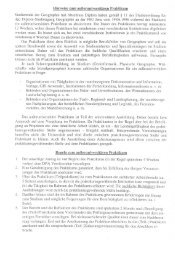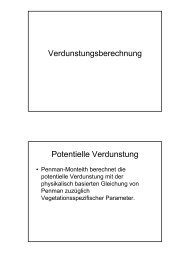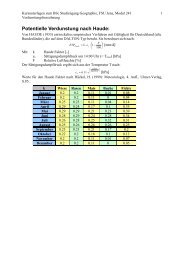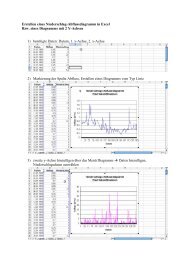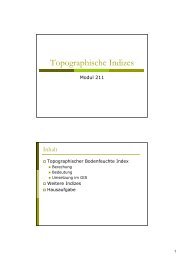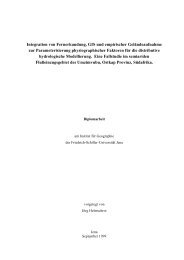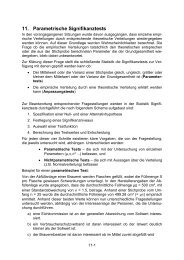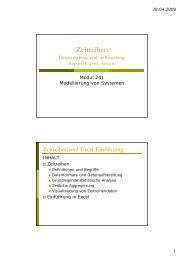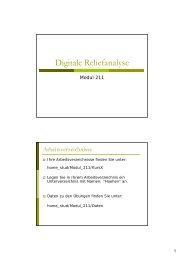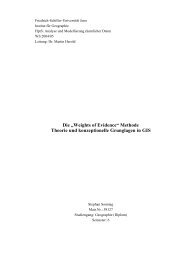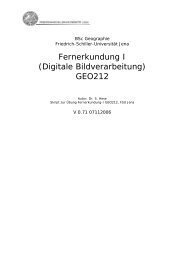Create successful ePaper yourself
Turn your PDF publications into a flip-book with our unique Google optimized e-Paper software.
23.06.2006 Bejing<br />
Response Units<br />
• and their application in soil<br />
<strong>erosion</strong> <strong>modelling</strong><br />
INWAMA<br />
Beijing 06.06.2006
State of the art in<br />
<strong>erosion</strong> <strong>modelling</strong><br />
INWAMA<br />
Beijing 06.06.2006
Conceptual model of aquatic <strong>erosion</strong> processes<br />
Soil particles<br />
from upslope<br />
soil particle<br />
detachment by<br />
precipitation<br />
Soil particle<br />
deatchment by runoff<br />
transport<br />
capacity<br />
precipitation<br />
transport<br />
capacity<br />
runoff<br />
total eroded soil<br />
(E)<br />
ET<br />
total transport<br />
capacity (T)<br />
soil particles carried<br />
downslope<br />
INWAMA<br />
Beijing 06.06.2006
Erosion models and <strong>modelling</strong> concepts<br />
degree of causality<br />
Conceptual<br />
grey-box-models<br />
physically based<br />
process oriented<br />
white-box-models<br />
Empiric<br />
black-boxmodels<br />
complexity / parameter requirement<br />
INWAMA<br />
Beijing 06.06.2006
Dilemma:<br />
Parameterization of <strong>erosion</strong> models<br />
• We are able to describe correctly the major part of <strong>erosion</strong><br />
processes (physics and mathematics)<br />
• Together with the degree of complexity the data requirement is<br />
growing<br />
Parameterization problems:<br />
• precipitation (spatial and temporal distribution)<br />
• soil complex (three dimensional dynamic)<br />
• socio economic complex<br />
limiting factor for <strong>erosion</strong> <strong>modelling</strong> data input<br />
INWAMA<br />
Beijing 06.06.2006
Scales in <strong>erosion</strong> <strong>modelling</strong><br />
scale integrative concepts ?<br />
Plot or field<br />
models<br />
Modelling entities<br />
distributed or aggregated<br />
Slope models<br />
spatial scale<br />
Catchment<br />
models<br />
Event based<br />
models<br />
Seasonal<br />
models<br />
Yearly average<br />
models<br />
time scale<br />
INWAMA<br />
Beijing 06.06.2006
Discretization approaches in <strong>erosion</strong> <strong>modelling</strong> to<br />
describe and subdivide a catchment<br />
aggregated<br />
<strong>modelling</strong><br />
entities<br />
catchment is<br />
characterized by average<br />
values<br />
process dynamic within<br />
the <strong>modelling</strong> entity is not<br />
described<br />
INWAMA<br />
Beijing 06.06.2006
Discretization approaches in <strong>erosion</strong> <strong>modelling</strong> to<br />
describe and subdivide a catchment<br />
distributed<br />
<strong>modelling</strong> units<br />
Catchment is divided into<br />
subunits which can be<br />
characterized specifically<br />
Process dynamics within<br />
the catchment can be<br />
simulated more accurately<br />
distributive approach:<br />
• allows the process based characterization of <strong>erosion</strong> dynamics on<br />
larger spatial scales<br />
• allows the application of modular <strong>modelling</strong> systems such like<br />
WEPP; LISEM<br />
INWAMA<br />
Beijing 06.06.2006
Regionalization and model coupling<br />
raster based<br />
approach<br />
allows the application<br />
of GIS<br />
each raster cell can be<br />
seen as a separate<br />
<strong>modelling</strong> unit<br />
Fix resolution:<br />
physiographic heterogeneity is sometimes not considered correctly<br />
INWAMA<br />
Beijing 06.06.2006
Regionalization and model coupling<br />
Response Units<br />
approach<br />
aggregated spatial<br />
objects with homogeneous<br />
process<br />
dynamics<br />
resolution is process<br />
based<br />
different processes can<br />
be exactly differentiated<br />
RU concept with the subdivision into sub entities with homogeneous<br />
process dynamics shows advantages in <strong>erosion</strong> <strong>modelling</strong><br />
INWAMA<br />
Beijing 06.06.2006
Aquatic <strong>erosion</strong> processes and forms depend on:<br />
• hydro-meteorologic dynamic of the catchment<br />
• characteristics of physiographical properties of the ecological<br />
subsystems (e.g. soil; vegetation)<br />
Suitable approaches in Hydrological Modelling<br />
Process oriented Response Units Approach allow:<br />
• identification,<br />
• characterization,<br />
• and <strong>modelling</strong> of the hydrologic dynamic of a catchment<br />
process oriented structure of the RU Approach allows<br />
the application to processes that are related to the<br />
hydrologic dynamic<br />
dynamics of <strong>erosion</strong> processes<br />
INWAMA<br />
Beijing 06.06.2006
Erosion Response Units (ERU) Concept<br />
represents a fully distributed <strong>modelling</strong> approach<br />
ERUs are:<br />
• heterogeneously structured terrain units<br />
• having homogeneous <strong>erosion</strong> process dynamics<br />
• that are controlled by the physiographic<br />
properties and the management of the human<br />
environment<br />
INWAMA<br />
Beijing 06.06.2006
Application of ERUs<br />
to identify the spatial distribution of <strong>erosion</strong> forms and –<br />
processes<br />
4. as <strong>modelling</strong> entity within the <strong>erosion</strong> <strong>modelling</strong><br />
5. in regional <strong>erosion</strong> <strong>modelling</strong> for spatial scale transfer<br />
With the ERU - concept it is possible to model separately<br />
heterogeneously distributed <strong>erosion</strong> processes<br />
INWAMA<br />
Beijing 06.06.2006
Erosion Response Units (ERU) Concept<br />
Reference units<br />
present <strong>erosion</strong><br />
forms and processes<br />
remote sensing<br />
erosivity<br />
System input<br />
Erosion Response Units<br />
system response<br />
Overlay analysis<br />
reclassification<br />
terrain characteristrics<br />
System characteristics<br />
Regionalization<br />
& <strong>modelling</strong><br />
atmosphere<br />
vegetation<br />
SVAT interface<br />
soil<br />
geomorphology<br />
geology<br />
INWAMA<br />
Beijing 06.06.2006
Delineation of reference units by stereo aerial photo interpretation<br />
Stereo aerial<br />
photos 1:30.000<br />
Analyses after Van Zuidam (1985)<br />
INWAMA<br />
Beijing 06.06.2006
Overlay procedure and classification of parameters<br />
• expert knowledge approach using defined rules<br />
• statistical approach e.g. CART<br />
INWAMA<br />
Beijing 06.06.2006
Derived ERU sequence by overlay analysis<br />
Layer 1 2 3 4<br />
Class ERefU Exposition<br />
Land cover Slope morphology Geology + soils<br />
1 no <strong>erosion</strong> North Unimproved<br />
grassland<br />
Convex/ concave<br />
slope 60m<br />
Alluvium Sand Loam<br />
Clay<br />
2 Slight rillinterrill;<br />
shallow<br />
<strong>gully</strong> <strong>erosion</strong><br />
East<br />
Shrub; bush &<br />
forests<br />
convex slope 1-5° & ><br />
60m<br />
partly consolidated<br />
Sediments<br />
(masotcheni)<br />
3 Rill-interrill;<br />
shallow -<br />
medium deep<br />
<strong>gully</strong> <strong>erosion</strong><br />
4 Rill; mediumdeep<br />
<strong>gully</strong><br />
<strong>erosion</strong><br />
South<br />
West<br />
Wetland/ water<br />
body<br />
Cultivated<br />
commercial/<br />
subsistence<br />
Concave slope 1-5° &<br />
> 60m<br />
Convex slope 5-10°&<br />
> 30m<br />
Basalts Dolerite Shales<br />
Mud-, Siltstone<br />
Diamectites Loam /Clay<br />
Basalts Dolerite Shales<br />
Mud-, Siltstone<br />
Diamectites Sand<br />
5 Rill; mediumdeep<br />
to, deep<br />
<strong>gully</strong> <strong>erosion</strong>,<br />
landslides<br />
6 Rill; deep <strong>gully</strong>;<br />
badlands;<br />
severe mass<br />
movements<br />
Urban<br />
Degraded<br />
unimproved<br />
grass-,<br />
bushland<br />
Concave slope 5-10°&<br />
> 30m<br />
Concave/convex<br />
slope >10° < 60m<br />
Gneiss Granite Diorite<br />
Sandstone Loam<br />
Gneiss Granite<br />
DioriteSandstone Sand/<br />
Clay<br />
INWAMA<br />
Beijing 06.06.2006
CART approach<br />
INWAMA<br />
Beijing 06.06.2006
Delineation and Regionalisation of ERUs<br />
Prediction model<br />
existing <strong>erosion</strong><br />
forms & processes<br />
INWAMA<br />
Beijing 06.06.2006
Delineation and Regionalisation of ERUs<br />
ERU<br />
related to<br />
a certain<br />
<strong>erosion</strong> intensity<br />
and specific<br />
<strong>erosion</strong> forms and<br />
processes<br />
INWAMA<br />
Beijing 06.06.2006
INWAMA<br />
Beijing 06.06.2006
Erosion <strong>modelling</strong><br />
ERU<br />
<strong>modelling</strong> unit<br />
Application of<br />
different inter-rill, rill <strong>erosion</strong> <strong>erosion</strong><br />
ACRU<br />
models<br />
<strong>modelling</strong> ERU unit<br />
Interface choosing model<br />
<strong>gully</strong> <strong>erosion</strong><br />
Gully models<br />
RUSLE dynamic <strong>gully</strong> model stable <strong>gully</strong> model<br />
system output<br />
Sediments in t/ha<br />
or mm<br />
routing of sediments<br />
(transport)<br />
INWAMA<br />
Beijing 06.06.2006
Modelling Structure<br />
(E)RU<br />
<strong>modelling</strong> unit<br />
Deep linear <strong>erosion</strong><br />
Gully <strong>erosion</strong><br />
Aquatic Erosion<br />
Rill-interrilll Erosion<br />
Deep linear <strong>erosion</strong><br />
Gully <strong>erosion</strong><br />
Process<br />
RUSLE<br />
Gully model<br />
Modelling<br />
Sediment routing and<br />
deposition module<br />
Integration<br />
Integrated catchment response<br />
Sediment yield<br />
INWAMA<br />
Beijing 06.06.2006
interrill-rill <strong>erosion</strong><br />
<strong>modelling</strong><br />
<strong>gully</strong> <strong>erosion</strong><br />
<strong>modelling</strong><br />
R-<br />
Faktor<br />
K-<br />
Faktor<br />
LS-<br />
Faktor<br />
C-<br />
Faktor<br />
P-Faktor<br />
1<br />
R<br />
*<br />
K<br />
*<br />
LS<br />
*<br />
C<br />
*<br />
P<br />
Soil loss per<br />
<strong>modelling</strong> unit<br />
1. Initial phase (5%) 2. Static phase (95%)<br />
Sidorchuk models<br />
INWAMA<br />
Beijing 06.06.2006
Mittel 8,1 to/ ha * Jahr<br />
Mittel 10,4 to/ ha * Jahr<br />
Mittel 15,0 to/ ha * Jahr<br />
INWAMA<br />
Beijing 06.06.2006
INWAMA<br />
Beijing 06.06.2006
<strong>gully</strong> <strong>modelling</strong><br />
initial phase<br />
static phase<br />
<strong>gully</strong> <strong>erosion</strong> model<br />
dynamic <strong>gully</strong><br />
<strong>erosion</strong> model<br />
(DIMGUL)<br />
static <strong>gully</strong> <strong>erosion</strong><br />
model (STABGUL)<br />
complete description of <strong>gully</strong> growth dynamics<br />
SIDORCHUK, et al. (2003); Sidorchuk et al. (2001), Sidorchuk & Sidrochuk (1999), Sidorchuk (1998)<br />
INWAMA<br />
Beijing 06.06.2006
DEM information<br />
hydrologic<br />
parameters<br />
dynamic &<br />
static <strong>gully</strong> models<br />
lithologic<br />
parameter<br />
Model output<br />
• <strong>gully</strong> profiles<br />
(longitudinal and cross scections)<br />
• eroded volume<br />
Gully <strong>erosion</strong> rates<br />
• <strong>gully</strong> drainage network<br />
timesteps/ final<br />
SIDORCHUK, et al. (2003); Sidorchuk et al. (2001), Sidorchuk & Sidrochuk (1999), Sidorchuk (1998)<br />
INWAMA<br />
Beijing 06.06.2006
<strong>gully</strong> <strong>erosion</strong> <strong>modelling</strong><br />
<strong>gully</strong> development after KOSOV et al. (1978)<br />
1. Initial phase<br />
(5% <strong>gully</strong> live time)<br />
1. Static phase<br />
(95% <strong>gully</strong> live time)<br />
90% <strong>gully</strong> length<br />
60% <strong>gully</strong> area<br />
35% <strong>gully</strong> volume<br />
INWAMA<br />
1: <strong>gully</strong> length<br />
2: <strong>gully</strong> depth<br />
3: <strong>gully</strong> area<br />
4: <strong>gully</strong> volume (Source: Sidorchuk 1999)<br />
Beijing 06.06.2006
dynamic <strong>gully</strong> <strong>erosion</strong> model<br />
dynamic <strong>gully</strong> <strong>erosion</strong> model (DIMGUL)<br />
• equation of mass conservation<br />
• equation for <strong>gully</strong> bed deformation<br />
∂Z/∂t – a(∂Z/∂x) – V f<br />
C=0<br />
Gully bed height<br />
SIDORCHUK, et al. (2003); Sidorchuk et al. (2001), Sidorchuk & Sidrochuk (1999), Sidorchuk (1998)<br />
INWAMA<br />
Beijing 06.06.2006
static <strong>gully</strong> <strong>erosion</strong> model<br />
static <strong>gully</strong> <strong>erosion</strong> model (STABGUL)<br />
hypothesis:<br />
• a final morphological equilibrium is existing<br />
- <strong>gully</strong> bed<br />
- <strong>gully</strong> side walls<br />
∂Z/∂t=0<br />
∂Wb/∂t=0<br />
V′ cr<br />
• Critical velocity V“ cr<br />
, for <strong>erosion</strong> initiation;<br />
• Roughness coefficient after MANNING n<br />
∀ φ angle of repose of stable <strong>gully</strong> side walls & <strong>gully</strong>bed<br />
Calibration with existing stable <strong>gully</strong> system<br />
INWAMA<br />
Beijing 06.06.2006
INWAMA<br />
Beijing 06.06.2006
Stereo aerial photo analyses<br />
with Zeiss Planicomp<br />
1961<br />
DEM with 1m X 1m<br />
resolution<br />
1977<br />
1990<br />
INWAMA<br />
Beijing 06.06.2006
Gully survey and Planicomp stereoscope analyses<br />
1944<br />
1977<br />
1984<br />
1996<br />
1998<br />
INWAMA<br />
Beijing 06.06.2006
validating of remotely<br />
sensed data<br />
INWAMA<br />
1998<br />
Beijing 06.06.2006
Results of <strong>gully</strong> <strong>erosion</strong> modeling<br />
• morphometric parameters follow Kosov- pattern<br />
• modelled and measured values show high conformity<br />
• final <strong>gully</strong> stadium can be simulated with dynamic model<br />
• high prediction goodness<br />
100<br />
90<br />
80<br />
70<br />
60<br />
50<br />
40<br />
30<br />
20<br />
10<br />
0<br />
Erosion rates for<br />
different stages<br />
1960 1990 2000 2010 2020 2030 2040 2050 2060 2070 2080 2090 2100 2110<br />
Gullytiefe Gullylänge Gullyfläche Gullyvolumen<br />
Kosov et al. 1978<br />
INWAMA<br />
Beijing 06.06.2006
static <strong>gully</strong> model<br />
INWAMA<br />
Beijing 06.06.2006
1990 2020 2050 2080 2110 1960<br />
2915000.00<br />
dynamic <strong>gully</strong> model<br />
2914800.00<br />
2914600.00<br />
2914400.00<br />
2914200.00<br />
38200.00 38400.00 38600.00 38800.00<br />
INWAMA<br />
Beijing 06.06.2006
Regionalisation of <strong>gully</strong> <strong>erosion</strong> results using Landsat TM and GIS<br />
analyses<br />
Transformed Soil Adjusted<br />
Vegetation Index (TSAVI)<br />
Mhlambanyoni river catchment<br />
TSAVI +ERU<br />
NIR<br />
INWAMA<br />
Red<br />
ca. 30 ha (0,75% of catchment area)<br />
Beijing 06.06.2006
Integration of distributed <strong>erosion</strong> modellling results<br />
Erosion<br />
models<br />
soil loss per unit<br />
area or pixel<br />
DEM +<br />
Rainfall<br />
Overlandflow<br />
per pixel<br />
Transport<br />
capacity<br />
Sediment<br />
routing<br />
Total sediment<br />
yield of catchment<br />
Integration over the<br />
catchment area<br />
INWAMA<br />
Beijing 06.06.2006
Sequential nesting of ERUs for sediment yield calculations<br />
Catchments are characterized by:<br />
2. Homogeneous geological structure<br />
3. Produced sediments show high silt and fine sand fractions<br />
4. Intensive precipitation with high runoff energy<br />
First approximation:<br />
no deposition<br />
eroded sediments are completely washed off the catchment<br />
Integrated sediment yield can be calculated<br />
with a simple sediment routing routine<br />
INWAMA<br />
Beijing 06.06.2006
Map of accumulated sediments along flowlines<br />
Percentage of sediments caused by<br />
<strong>gully</strong> <strong>erosion</strong> is up to 30% !<br />
<strong>gully</strong> areas



